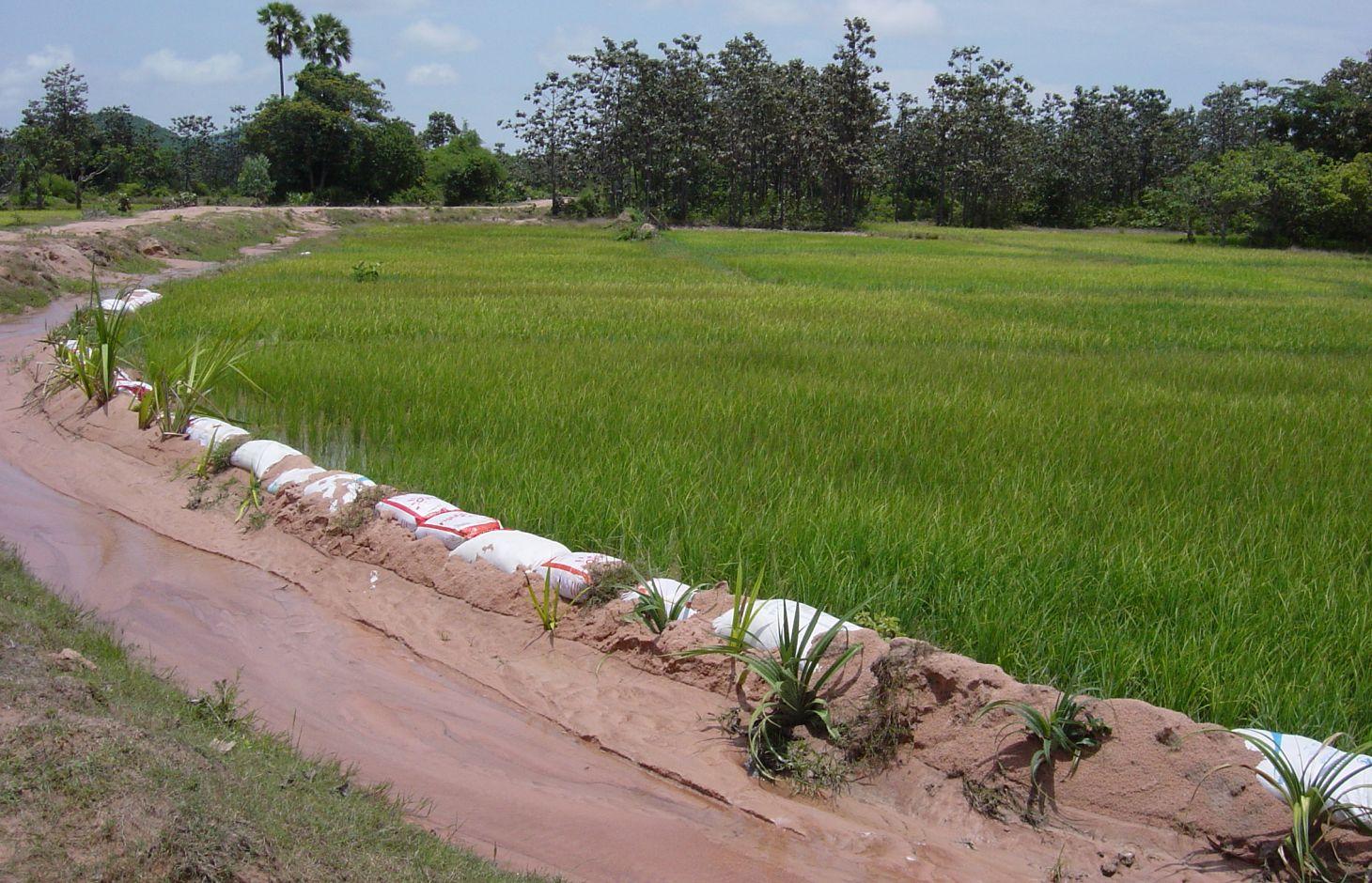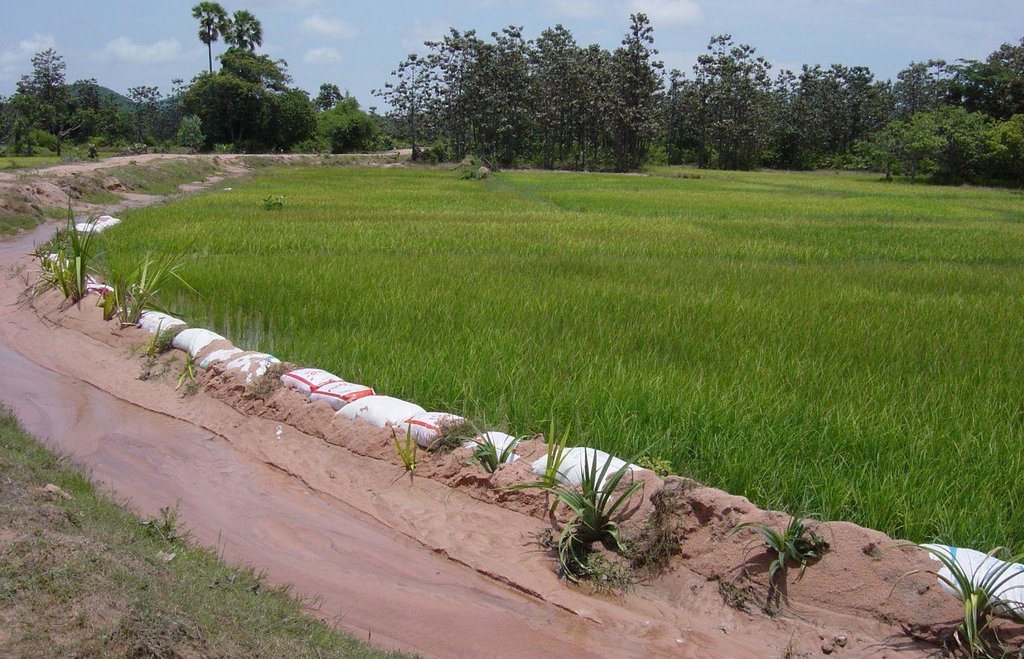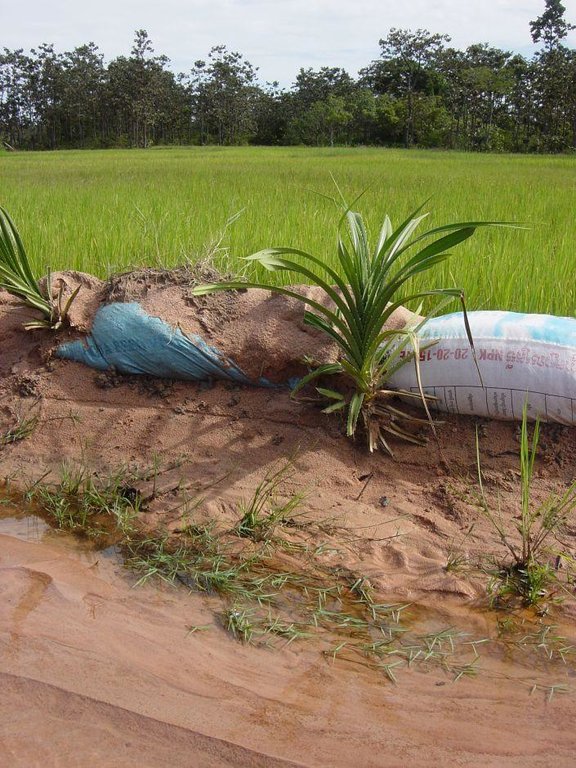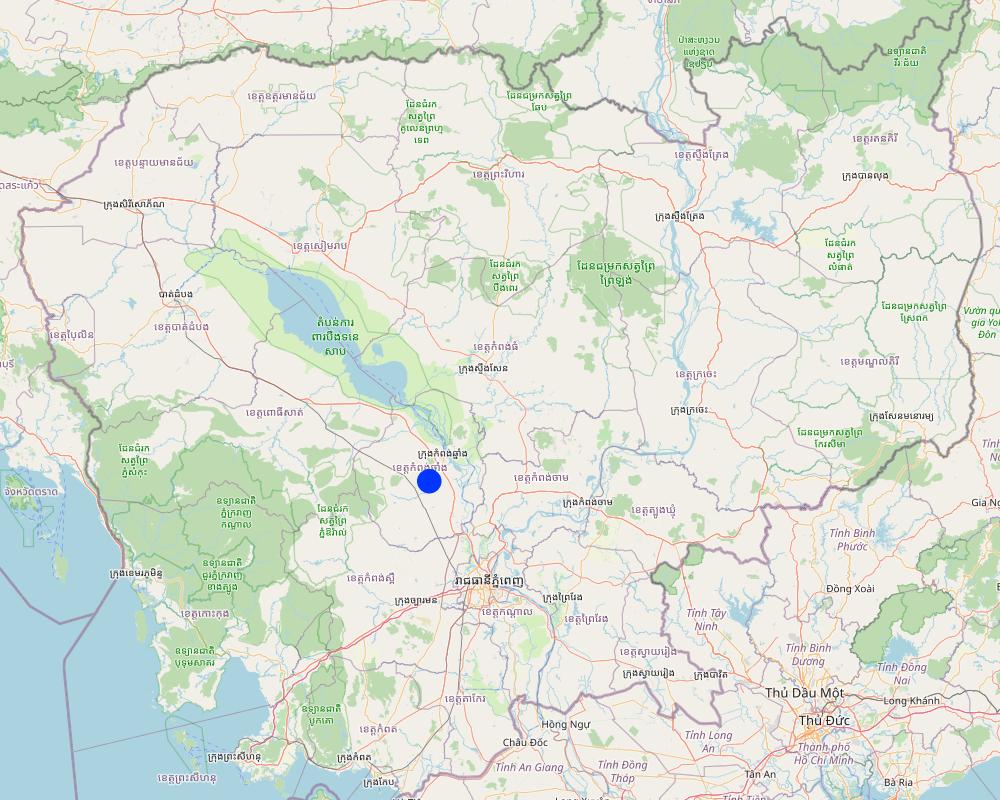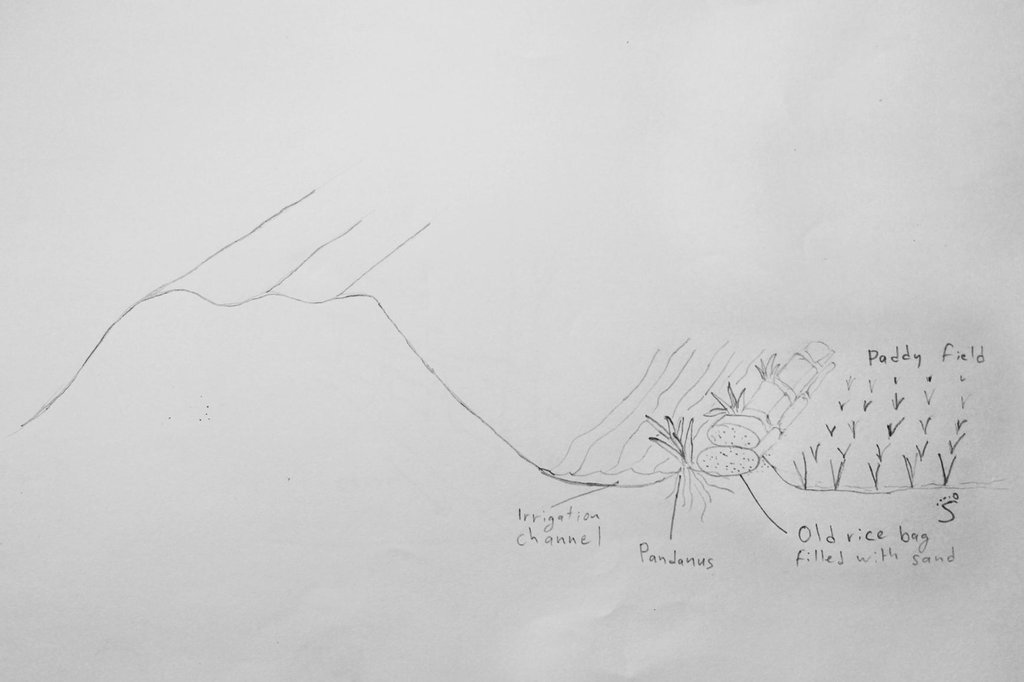Stabilisation of irrigation channels in sandy soils with old rice bags and Pandanus plants [柬埔寨]
- 创建:
- 更新:
- 编制者: Stefan Graf
- 编辑者: –
- 审查者: Deborah Niggli, Alexandra Gavilano, Rima Mekdaschi Studer
បច្ចេកទេសដាក់បាវខ្សាច់ និងដាំដើមរំចេកតាមភ្លឺស្រែជាទំនប់ទប់ការហូរច្រោះ (Khmer)
technologies_1650 - 柬埔寨
- Stabilisation of irrigation channels in sandy soils with old rice bags and Pandanus plants: Feb. 28, 2017 (inactive)
- Stabilisation of irrigation channels in sandy soils with old rice bags and Pandanus plants: March 11, 2019 (inactive)
- Stabilisation of irrigation channels in sandy soils with old rice bags and Pandanus plants: Feb. 7, 2024 (public)
查看章节
全部展开 全部收起1. 一般信息
1.2 参与该技术评估和文件编制的资源人员和机构的联系方式
SLM专业人员:
Khun Lean Hak
SOFDEC/LAREC, www.sofdec.org
柬埔寨
SLM专业人员:
Pith Khonhel
LAREC
柬埔寨
有助于对技术进行记录/评估的机构名称(如相关)
Society for Community Development in Cambodia (SOFDEC) - 柬埔寨有助于对技术进行记录/评估的机构名称(如相关)
Local Agricultural Research and Extension Centre (LAREC) - 柬埔寨1.3 关于使用通过WOCAT记录的数据的条件
编制者和关键资源人员接受有关使用通过WOCAT记录数据的条件。:
是
1.4 所述技术的可持续性声明
这里所描述的技术在土地退化方面是否存在问题,导致无法被认为是一种可持续的土地管理技术?:
否
2. SLM技术的说明
2.1 技术简介
技术定义:
In sandy areas, old rice bags are filled with sand and piled up as dikes bordering irrigation channels, and Pandanus plants are used to stabilize them on the long term.
2.2 技术的详细说明
说明:
The paddy fields are surrounded by dikes and fed by local temporary streams and irrigation channels, as well as by rain. In sandy soils the dikes around the irrigation channels and fields cannot hold the water due to erosion. Old rice bags are filled with sand and piled up to form stable dikes on the short term, and Pandanus suckers are planted every 0.5 – 1 m to ensure a stability on the long term due to the root system.
The purpose of the dikes, stabilized for short and long term, is to ensure the flow of water to the paddy fields by reducing the riverbank erosion. It also helps to keep the water in the paddy fields. The Pandanus can be used to make mats and baskets, although this use diminishes due to the low cost of plastic. After a few years, the Pandanus on the dike is tall and spiky enough to fence off cattle and protect the rice from grazing.
To stabilize 50 m of dike, around 100 old rice bags are filled with sand and piled up on a height of 2 bags. Pandanus suckers are planted on the water side, between the bags, and sand is used to cover the plants and bags. Poles and sticks are used to stabilize the bags and plants until the root system is established. This is done in the beginning of the rainy season to ensure the growth of the sucker. In the first year, after each rain the eroded sand has to be added back to the dike. After the establishment phase, from the second year on, the Pandanus have to be cut back as they grow quickly and can grow tall.
The analysed area is flat (slope < 2%), with a tropical climate (dry season from November to May and wet season from June to October), and the soils are mostly sandy or loamy. The soil has a low fertility, contains little organic matter, and acidifies. The area has been deforested a long time ago, and the groundwater table is rather high (1-2 m during the dry season, on the surface during wet season).
Due to climate change, farmers notice more erratic rainfall, temperature rises and more recurrent droughts. Rice is the predominant crop grown in the area, since it serves as staple food (mix subsistence and commercial activities). Cattle are usually grazing on the fields after the harvest, without much control. Thus the cattle grazes too often and too much on the same spot, leading to degradation.
The increasing migration rate (the young generation leaves the villages to work in the cities, garment industry or abroad) results in a decrease of available labour force in the area which has detrimental effects on the agricultural activities. Furthermore, the civil war in the 1970s (Khmer Rouge) led to the loss of agricultural knowledge. Several NGOs are trying to re-establish the knowledge.
2.3 技术照片
2.5 已应用该技术的、本评估所涵盖的国家/地区/地点
国家:
柬埔寨
区域/州/省:
Kampong Chhnang
有关地点的进一步说明:
Chrey Bak/Rolea Pha’ear
具体说明该技术的分布:
- 均匀地分布在一个区域
如果不知道精确的区域,请注明大致覆盖的区域:
- 1-10 平方千米
注释:
Traditionally the irrigation channels were stabilized with sticks and some fences (old sugar palm leaves roofs…) This is changing now, as old rice bags become available.
Map
×2.6 实施日期
如果不知道确切的年份,请说明大概的日期:
- 50多年前(传统)
2.7 技术介绍
详细说明该技术是如何引入的:
- 作为传统系统的一部分(> 50 年)
注释(项目类型等):
The use of Pandanus plants to stabilise the irrigation channels and dikes is a traditional setting in the area. The use of rice bag is a newer setting.
3. SLM技术的分类
3.1 该技术的主要目的
- 创造有益的经济影响
- 创造有益的社会影响
3.2 应用该技术的当前土地利用类型

农田
- 一年一作
年作 - 具体指明作物:
- 谷类 - 水稻(湿地)
每年的生长季节数:
- 1
具体说明:
Longest growing period in days: 210, Longest growing period from month to month: June to December

水道、水体、湿地
注释:
Major land use problems (compiler’s opinion): low soil fertility, overgrazing, lack of irrigation
Major land use problems (land users’ perception): lack of irrigation, low soil fertility
Livestock is grazing on crop residues
3.4 供水
该技术所应用土地的供水:
- 混合雨水灌溉
3.5 该技术所属的SLM组
- 灌溉管理(包括供水、排水)
- 引水和排水
- 地表水管理(泉、河、湖、海)
3.6 包含该技术的可持续土地管理措施

植物措施
- V1:乔木和灌木覆盖层

结构措施
- S3:分级沟渠、渠道、水道
3.7 该技术强调的主要土地退化类型

土壤水蚀
- Wr:河岸侵蚀

水质恶化
- Ha:干旱化
注释:
Main causes of degradation: soil management (Lack of organic matter), labour availability (Factory work in garment industry)
Secondary causes of degradation: crop management (annual, perennial, tree/shrub) (mainly annuals are planted in monocultures (rice)), overgrazing (free ranging of cattle)
3.8 防止、减少或恢复土地退化
具体数量名该技术与土地退化有关的目标:
- 防止土地退化
- 减少土地退化
4. 技术规范、实施活动、投入和成本
4.1 该技术的技术图纸
技术规范(与技术图纸相关):
Next to a road, (left) there is an irrigation channel in sandy soil. To prevent the little dam next to the rice field (right) from eroding, old rice bags are filled with sand and piled up. Between the rice bags, Pandanus suckers are planted. Sometimes they are also used to stabilise roadsides (not shown in this picture).
Kampong Chhnang
Date: 2014
Technical knowledge required for field staff / advisors: low
Technical knowledge required for land users: low
Main technical functions: stabilisation of soil (eg by tree roots against land slides), water harvesting / increase water supply, sediment retention / trapping, sediment harvesting
Vegetative measure: On dikes, allong irrigation channels
Vegetative material: T : trees / shrubs
Vertical interval within rows / strips / blocks (m): 0.5 - 1 m
Vegetative measure: Vegetative material: T : trees / shrubs
Trees/ shrubs species: Pandanus grown from suckers
Bund/ bank: graded
Height of bunds/banks/others (m): 0.3
Width of bunds/banks/others (m): 0.75
Construction material (other): Sand and sandbags
Vegetation is used for stabilisation of structures.
作者:
Stefan Graf, Switzerland
4.2 有关投入和成本计算的一般信息
其它/国家货币(具体说明):
Riels
如相关,注明美元与当地货币的汇率(例如1美元=79.9巴西雷亚尔):1美元=:
4000.0
注明雇用劳工的每日平均工资成本:
5.00
4.3 技术建立活动
| 活动 | 时间(季度) | |
|---|---|---|
| 1. | Fill the old rice bags with sand, pile them up, stabilize with sticks and add more sand after each rain, till the root system of the Pandanus plants have established (1 year) | Beginning of wet season (Jun/Jul) |
| 2. | Plant the Pandanus suckers between the bags | beginning of wet season (June/July) |
4.4 技术建立所需要的费用和投入
| 对投入进行具体说明 | 单位 | 数量 | 单位成本 | 每项投入的总成本 | 土地使用者承担的成本% | |
|---|---|---|---|---|---|---|
| 肥料和杀菌剂 | Construction of biodigester | 1.0 | 400.0 | 400.0 | 50.0 | |
| 技术建立所需总成本 | 400.0 | |||||
| 技术建立总成本,美元 | 0.1 | |||||
注释:
Duration of establishment phase: 12 month(s)
4.5 维护/经常性活动
| 活动 | 时间/频率 | |
|---|---|---|
| 1. | Maintain the dikes | every rainy season |
| 2. | Cut back the Pandanus plants | Once a year, before planting rice |
4.6 维护/经常性活动所需要的费用和投入(每年)
| 对投入进行具体说明 | 单位 | 数量 | 单位成本 | 每项投入的总成本 | 土地使用者承担的成本% | |
|---|---|---|---|---|---|---|
| 劳动力 | labour | 1.0 | 121.5 | 121.5 | 100.0 | |
| 技术维护所需总成本 | 121.5 | |||||
| 技术维护总成本,美元 | 0.03 | |||||
注释:
Machinery/ tools: showel, knife, Shovel, knife
The costs were calculated in 2014 for 50 m of dike (50 m = 1 unit). To protect an irrigation channel of a 50 m, 100 m of dike would be needed, as the dikes would be on both sides.
4.7 影响成本的最重要因素
描述影响成本的最决定性因素:
The labour is the most costly part in this technology. Through the use of old rice bags filled with sand the costs are already reduced.
5. 自然和人文环境
5.1 气候
年降雨量
- < 250毫米
- 251-500毫米
- 501-750毫米
- 751-1,000毫米
- 1,001-1,500毫米
- 1,501-2,000毫米
- 2,001-3,000毫米
- 3,001-4,000毫米
- > 4,000毫米
有关降雨的规范/注释:
1486.45 mm 2013 in Kampong Chhnang
农业气候带
- 半湿润
Thermal climate class: tropics. 27° to 35°C
5.2 地形
平均坡度:
- 水平(0-2%)
- 缓降(3-5%)
- 平缓(6-10%)
- 滚坡(11-15%)
- 崎岖(16-30%)
- 陡峭(31-60%)
- 非常陡峭(>60%)
地形:
- 高原/平原
- 山脊
- 山坡
- 山地斜坡
- 麓坡
- 谷底
垂直分布带:
- 0-100 m a.s.l.
- 101-500 m a.s.l.
- 501-1,000 m a.s.l.
- 1,001-1,500 m a.s.l.
- 1,501-2,000 m a.s.l.
- 2,001-2,500 m a.s.l.
- 2,501-3,000 m a.s.l.
- 3,001-4,000 m a.s.l.
- > 4,000 m a.s.l.
5.3 土壤
平均土层深度:
- 非常浅(0-20厘米)
- 浅(21-50厘米)
- 中等深度(51-80厘米)
- 深(81-120厘米)
- 非常深(> 120厘米)
土壤质地(表土):
- 粗粒/轻(砂质)
表土有机质:
- 中(1-3%)
- 低(<1%)
5.4 水资源可用性和质量
地下水位表:
表面上
地表水的可用性:
好
水质(未处理):
不良饮用水(需要处理)
关于水质和水量的注释和进一步规范:
during wet seasons
5.5 生物多样性
物种多样性:
- 低
5.6 应用该技术的土地使用者的特征
生产系统的市场定位:
- 生计(自给)
- 混合(生计/商业)
非农收入:
- 收入的10-50%
相对财富水平:
- 平均水平
- 丰富
个人或集体:
- 个人/家庭
性别:
- 女人
- 男人
说明土地使用者的其他有关特征:
Land users applying the Technology are mainly common / average land users
Population density: 10-50 persons/km2
Annual population growth: 0.5% - 1%
Off-farm income specification: handicraft, remittances and factory work
5.7 应用该技术的土地使用者使用的平均土地面积
- < 0.5 公顷
- 0.5-1 公顷
- 1-2 公顷
- 2-5公顷
- 5-15公顷
- 15-50公顷
- 50-100公顷
- 100-500公顷
- 500-1,000公顷
- 1,000-10,000公顷
- > 10,000公顷
这被认为是小规模、中规模还是大规模的(参照当地实际情况)?:
- 中等规模的
5.8 土地所有权、土地使用权和水使用权
土地所有权:
- 社区/村庄
- 个人,未命名
土地使用权:
- 社区(有组织)
- 个人
用水权:
- 自由进入(无组织)
注释:
land users have a title which is not recognized by the state
5.9 进入服务和基础设施的通道
健康:
- 贫瘠
- 适度的
- 好
教育:
- 贫瘠
- 适度的
- 好
技术援助:
- 贫瘠
- 适度的
- 好
就业(例如非农):
- 贫瘠
- 适度的
- 好
市场:
- 贫瘠
- 适度的
- 好
能源:
- 贫瘠
- 适度的
- 好
道路和交通:
- 贫瘠
- 适度的
- 好
饮用水和卫生设施:
- 贫瘠
- 适度的
- 好
金融服务:
- 贫瘠
- 适度的
- 好
6. 影响和结论性说明
6.1 该技术的现场影响
社会经济效应
生产
作物生产
注释/具体说明:
Dried residues are put in the garden (cucumber, pumpkin, watermelon) which increases nutrient availability.
饲料生产
生产故障风险
生产区域
能源生产
注释/具体说明:
Before the installation of the biogas system, the land user bought firewood.
收入和成本
农业投入费用
注释/具体说明:
He saves 50 $ on chemical fertilizer per year.
农业收入
收入来源的多样性
工作量
社会文化影响
食品安全/自给自足
健康状况
注释/具体说明:
No smoke from open fire.
contribution to human well-being
注释/具体说明:
On the long term livelihood is improved, because he saves over 60 $ per year in firewood and battery charging for light, as well as 50 $ for chemical fertilizer.
生态影响
水循环/径流
水量
水质
注释/具体说明:
Pollution of groundwater due to washing out of nutrients.
土壤
土壤水分
土壤流失
土壤有机物/地下C
注释/具体说明:
Most of the carbon is transformed into methane, not available as organic matter.
生物多样性:植被、动物
害虫/疾病控制
其它生态影响
Reduced weed seeds
注释/具体说明:
Compost usually not completely decomposed, as well as raw manure, contain lots of weed seeds.
6.2 该技术的场外影响已经显现
地下水/河流污染
注释/具体说明:
Sludge is left to dry outside, nutrients washed out into groundwater. Not measurable.
6.3 技术对渐变气候以及与气候相关的极端情况/灾害的暴露和敏感性(土地使用者认为的极端情况/灾害)
渐变气候
渐变气候
| 季节 | 增加或减少 | 该技术是如何应对的? | |
|---|---|---|---|
| 年温度 | 增加 | 好 |
气候有关的极端情况(灾害)
气象灾害
| 该技术是如何应对的? | |
|---|---|
| 局地暴雨 | 未知 |
| 局地风暴 | 好 |
气候灾害
| 该技术是如何应对的? | |
|---|---|
| 干旱 | 好 |
水文灾害
| 该技术是如何应对的? | |
|---|---|
| 比较和缓的(河道)洪水 | 未知 |
其他气候相关的后果
其他气候相关的后果
| 该技术是如何应对的? | |
|---|---|
| 缩短生长期 | 好 |
6.4 成本效益分析
技术收益与技术建立成本相比如何(从土地使用者的角度看)?
短期回报:
积极
长期回报:
积极
技术收益与技术维护成本/经常性成本相比如何(从土地使用者的角度看)?
短期回报:
非常积极
长期回报:
非常积极
注释:
Difficult question for farmers.
6.5 技术采用
在所有采用这项技术的人当中,有多少人是自发的,即未获得任何物质奖励/付款?:
- 91-100%
注释:
100% of land user families have adopted the Technology without any external material support
The farmers guessed that around 10 % of the land users use this technology in the area. There is a moderate trend towards spontaneous adoption of the Technology
The sandbags reduce the labour, thus are used more and more even though they cost.
6.7 该技术的优点/长处/机会
| 土地使用者眼中的长处/优势/机会 |
|---|
| The Pandanus leaves are used for baskets and mats. |
| The water is stored in the rice fields. Without stabilisation, the berms would not hold any water at all in sandy conditions. |
| Cattle is fenced off the rice fields through tall and thick (old) Pandanus plants growing on the dikes. |
| The irrigation channels are not eroded, water keeps flowing |
6.8 技术的弱点/缺点/风险及其克服方法
| 土地使用者认为的弱点/缺点/风险 | 如何克服它们? |
|---|---|
| The Pandanus grow too quickly and too tall, and require workload which is not available. | Select slow growing species or individuals. |
| Rodents use the Pandanus as niches. | Protect natural predators (snakes), or hunt/trap the rodents. |
| 编制者或其他关键资源人员认为的弱点/缺点/风险 | 如何克服它们? |
|---|---|
| the plastic from the rice bags disintegrates with time and causes river pollution. | Use organic material (e.g. rice bags) to stabilize the dike for the first year. |
7. 参考和链接
7.1 信息的方法/来源
- 实地考察、实地调查
- 与土地使用者的访谈
(现场)数据是什么时候汇编的?:
29/08/2014
7.2 参考可用出版物
标题、作者、年份、ISBN:
NBP National Biodigester Program
可以从哪里获得?成本如何?
www.nbp.org.kh
标题、作者、年份、ISBN:
Lam et al. 2009. Domestic Biogas Compact Course. University of Oldenburg.
可以从哪里获得?成本如何?
http://www.nbp.org.kh/publication/study_report/2_domestic_biogas%20.pdf
标题、作者、年份、ISBN:
Gurung. 2009. Review of Literature on Effects of Slurry Use on Crop production. The Biogas Support Program
链接和模块
全部展开 全部收起链接
无链接
模块
无模块


